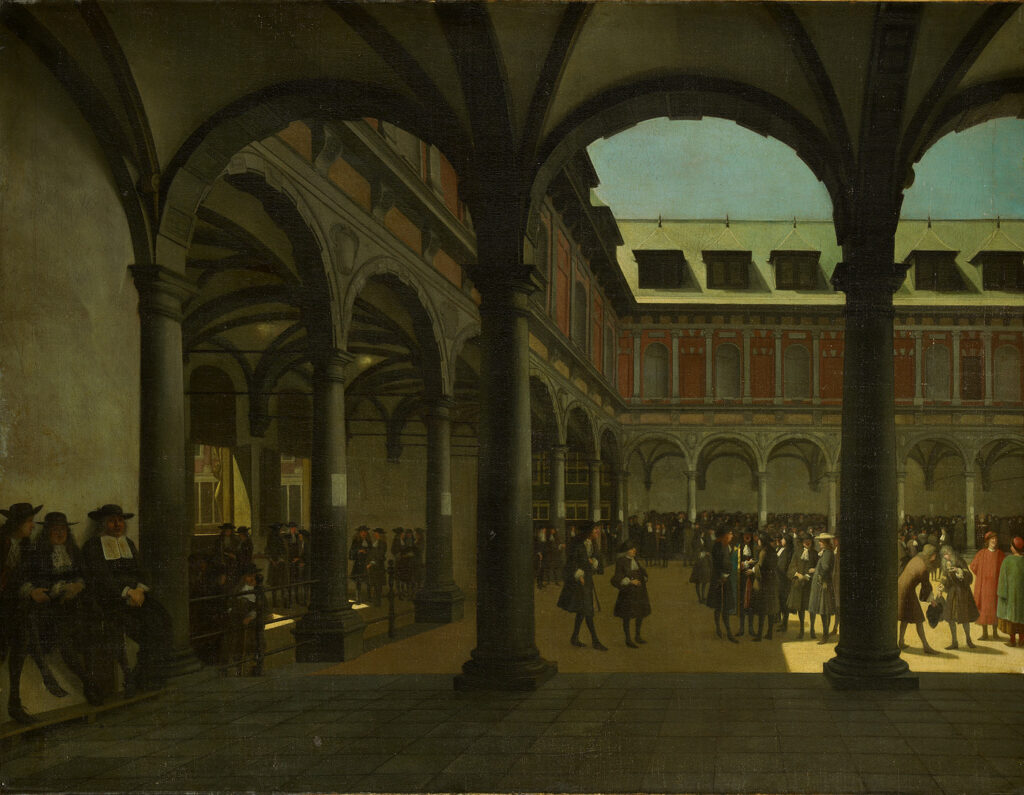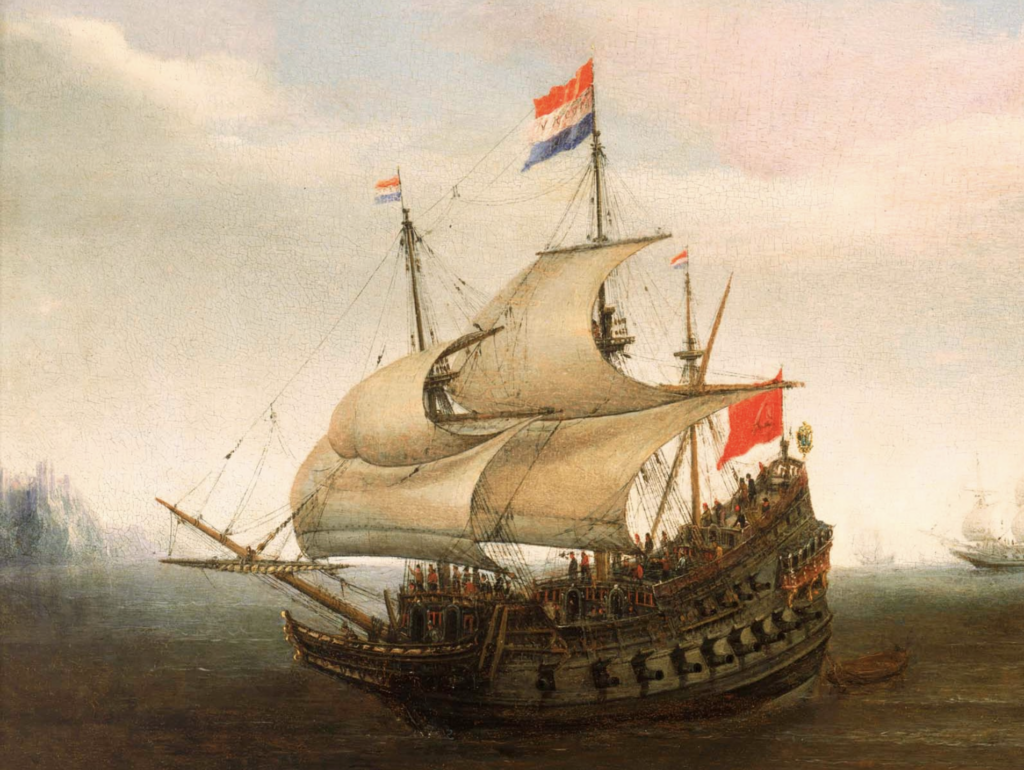Last updated on November 4th, 2023 at 10:26 pm
The Dutch East India Company (Vereenigde Oost-Indische Compagnie, or VOC) was the most valuable corporation in history. It was founded in 1602 to trade mainly in spices and quickly became the most influential company in the world.
The company had a 21-year monopoly granted by the Dutch government on many of the world’s markets and had its own private army and navy.
It was indeed an incredible display of human ingenuity and organization—so much so that it sent 1 million voyagers to Asia putting the rest of Europe combined to shame.

History of the Dutch East India Company
In 1602, the Dutch East India Company was established with its headquarters in the Oost-Indisch Huis (East-India House) in the heart of Amsterdam.
The Dutch Republic (modern-day Netherlands) established the trading firm to safeguard Dutch commerce in the Indian Ocean and support the Dutch resistance movement against Spanish colonial rule.
Throughout the majority of the 17th century, the Dutch East India Company served as the instrumental arm of the Dutch economic empire in the East Indies (modern-day Indonesia), which it helped to build and expand until its eventual dissolution.
The Dutch government granted the company a monopoly on trade in the waters between the southern tip of Africa (Cape of Good Hope) and the Straits of Magellan (connecting the Atlantic and Pacific Oceans), as well as the authority to make treaties with local princes, construct forts and maintain armies, and carry out administrative duties using officials who were sworn to loyalty to the Dutch government.
The company was able to expel the Portuguese from the East Indies and destroy the British navy thanks to the leadership of tenacious governors-general like Jan Pieterszoon Coen (1618-23) and Anthony van Diemen (1636-45).
The corporation was also the first legitimate company to issue stocks, which peaked during the Dutch “Tulip Mania,” a passion for tulip bulbs that is regarded as the world’s first major financial bubble. It even had 70,000 workers at one time, a remarkable feat for a business founded more than 400 years ago.
During their century of dominance, VOC had a massive international reach. Its ability to command fleets capable of repelling navy attacks and seizing territory is remarkable for a privately owned firm.
It was the VOC that gave rise to the concept of globalism. Europeans desired Asian spices and textiles, but Asia had few needs that Europeans could satisfy. In exchange, however, Asia was interested in the precious metals that Portugal and Spain had in great quantity.

In 1619, the corporation renamed Jacatra Batavia (present-day Jakarta) and used it as a springboard to conquer Java and the surrounding islands. The company’s influence in Java’s politics and commerce became increasingly prominent as the 17th century progressed.
Around the turn of the 18th century, the firm shifted from being a commercial maritime concern to a more loosely organized territorial group focused on the agricultural products of the Indonesian archipelago.
By the close of the 18th century, the business was deeply in debt and plagued by corruption. In 1799, the Dutch government canceled the business’s charter and assumed responsibility for the debts and assets of the corporation.
Why the VOC is the most valuable corporation in history
Let’s look at how this company dominated the world markets for around 200 years.
Established Monopolies
The Dutch East India Company monopolized many markets, including coffee, tea, tobacco, silk, porcelain, spices, and saltpeter.
This allowed them to dictate prices and reap huge profits from their trading activities. In addition to obtaining monopolies on these products, they also created a system of trade that was highly efficient and allowed them to move goods quickly between countries with minimal losses.
Military Power
The VOC established its own private military force to protect its interests from pirates or other competitors. This included a land army and a fleet of ships equipped with cannons and other weapons.
This private military force successfully protected VOC interests and allowed them to expand their trading networks further.
Financial System Innovations
The VOC also developed innovative financial systems that helped them manage their wealth more effectively. They were among the first companies to issue stocks and bonds, allowing them to raise capital quickly while maintaining control over their finances.
Additionally, they could use derivatives such as futures contracts to hedge against price fluctuations in specific markets.
How do Modern-day companies compare to The Dutch East India Company?
Today’s businesses have evolved into a massive and dynamic global network thanks to technological advancements, communication, shipping, and investment capabilities.
Where The Dutch East India Company relied on physical resources such as ships to transfer goods from its many geopolitical ports, modern companies are not limited by physical distance or resources; instead, they can easily take advantage of digital technologies for global collaborations that span vast distances and even entire hemispheres.
By capitalizing on modern technologies like cloud computing and robotics, today’s companies can work faster and more efficiently than ever!
Still, it’s impressive that in the 1600s, the Dutch East India Company made it to 78 million guilders, which translates to $7.9 trillion in current dollars. To put things clearly, adding the market caps of 20 of the world’s largest companies, including Apple, Microsoft, and Amazon, gets us to $7.9 trillion.
The dark side of The Dutch East India Company
The Dutch East India Company (VOC) hugely impacted the global economy and trading during its mercantile period from 1602 to 1798. Establishing trade routes and creating monopolies, the VOC contributed to global feats of exploration and scientific discovery.
However, not all was rosy in this company’s lifespan – reports tell tales of brutality, torture, and slavery among its practices. Tales undoubtedly made the boardroom a bit tenser when it came time to talk sales forecasts! The truth is that all companies have their dark side, but some are darker than others.
The VOC was incredibly profitable and had a remarkable influence on world history. At the same time, they displayed ruthless behavior as they competed with other European companies for control of lucrative trading colonies. Today, we can look back at this powerful company and learn from its story’s light and dark sides.
The Most Valuable Company Of All Time
The Dutch East India Company dominated world markets for over two centuries due to its ability to obtain monopolies on certain products, maintain its military forces, and develop innovative financial systems that allowed it to manage its wealth more effectively than any other company.
The legacy of the VOC still lives on today through modern corporations that employ similar strategies for success, like creating monopolies on specific products or services and using stocks & bonds for financing operations.
While some may argue that modern corporations have taken these tactics too far in some cases, there is no denying that without this pioneering company from long ago, we would not be where we are today regarding corporate powerhouses dominating global markets.


Can you recommend any books that cover the VOC history? Thanks in advance.